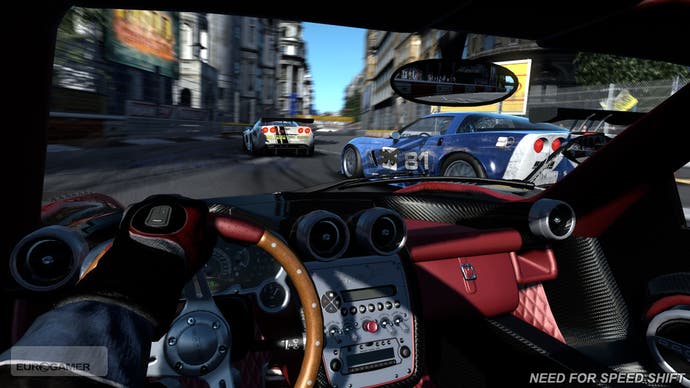Need for Speed: Shift
Back on track?
The team seems to be doing a decent job in this respect, layering on a handful of telling little details to increase the sense of immersion: put your foot down and the depth of field changes, keeping the track in sharp focus while gently blurring out the cockpit, and even making your character's grip on the wheel tighten almost imperceptibly. Sudden accelerations are also coupled with camera shake and the screen pulling out to mimic your head being pushed back into the seat, while emergency braking contracts your view suddenly as you lurch forward again.
On top of this, the developers have spent a lot of time thinking about the too-often hum-drum activity of crashing, eager to capture the drama of collisions as a brutal bodily event as much as an annoying kink in your lap time. The solution so far is optical overload, collisions sending the screen into a screaming blur as your vision dissolves into a shimmering watery mass, and your heartbeat grows increasingly audible on the soundtrack. Compared to the Hollywood explosions of Burnout, it's a far more physical approach: the videogame equivalent of getting Tabasco in your eye. It's jarring rather than terrifying, then, but it's also far from cosmetic, as the damage modelling is keyed into the physics engine: after a series of bad racing decisions have reduced the clean lines of the Zonda to a clanking pile of abstract expressionism, the resulting mess handles very differently, sluggishly chugging down the road, and cutting through the oncoming breeze with all the grace of an old mattress.

Switching from Brands Hatch to a race on an imaginary track that threads itself around tourist book London, provides yet another opportunity to focus on just how good the game looks. These are streets already made familiar by PGR3, but here they're more richly detailed, with the buildings looming much closer over the track, the surrounding roads bustling with crowds, and a range of on-the-fly lighting effects allowing developers to switch between different types of weather and shunt the clock back and forth between the blooming orange glow of early evening to the shimmering pale sunlight of noon in seconds.
London's also a chance to see just how deeply the sim elements of the game are embedded into the design. Turning off the HUD entirely while in-cockpit allows you to drive by the dials alone, while a colour-coded racing line is projected onto the ground in front of you, red and yellow telling you when to brake, green encouraging you to floor it, while blue suggests you're lagging behind. It's serious stuff for a traditionally arcadey series, and, coupled with entirely new car physics - there's a much weightier sense of your tyres hugging the road, but if you're not careful on the corners, you can still end up in a spin - is enough to make Maggie Q seem like a distant memory.

While it's hard to avoid suspicions about how Shift came to be - its new developer, new direction, and surprising level of polish suggesting its link to the Need for Speed franchise may be fairly opportunistic - there's no reason yet to question the quality of what Slightly Mad has been working on. Whether or not you believe EA's notion that the videogame audience is now so deeply fragmented it needs three separately tailored titles in order to please everyone, it's clear that, if you're after the series' more familiar style of gameplay, you'll need to wait for Nitro on the DS and Wii for the time being. However, if you're a fan of driving as much as just racing, Shift is looking like the best thing to emerge from the strange new art of inverse milking in quite a while.
Need for Speed: Shift is due for release on PS3, Xbox 360, PC and PSP this winter.

